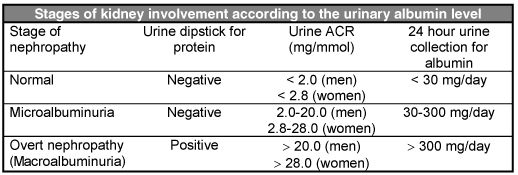Risk Factors
Microalbuminuria 1,2
Diabetic kidney disease or nephropathy is the most common cause of end
stage renal disease (ESRD) or kidney failure in the Western World. One
of the earliest markers of diabetic nephropathy is the presence of small
amount of the protein albumin in the urine. This is called MAU or microalbuminuria
(urinary albumin excretion of 30-300 mg/24 hours). Microalbuminuria may
progress over a span of a number of years to overt nephropathy characterized
by the presence of larger amounts of the protein albumin leaking through
the kidneys’ filter mechanism into the urine. This is called macroalbuminuria
(urinary albumin > 300 mg/24 hours). The presence of macroalbuminuria
indicates more serious kidney disease. Progression to ESRD or kidney failure
may then occur within several years. Once overt kidney failure has developed
2 year survival is approximately 50%.
Studies have shown that presence of microalbuminuria is reversible with
interventions to tightly control blood sugar and blood pressure. Microalbuminuria
may sometimes resolve on its own. Specific medications including angiotensin
converting enzyme inhibitors (ACE inhibitors) and angiotensin receptor
blockers (ARBs) have been shown to halt and reverse the presence of MAU
and delay the progression to ESRD and the need for dialysis. In some cases
a combination of both agents is indicated to protect the kidneys. This
may be indicated when the creatinine clearance (a measure of kidney function)
is ≤ 60 mL/min. Screening for MAU is recommended in all post-pubertal
type 1 with diabetes ≥ 5 years duration and all type 2 diabetics
on an annual basis.
MAU is measured on spot early morning urine collections, timed urine collections
or as a ratio of albumin to creatinine the urine (ACR). The ACR is the
preferred method as it does not require early morning or timed collections,
it correlates with the 24-hour urine values over a large range of proteinuria,
it is cheap to perform, and repeat values can be easily obtained to be
certain ascertain that microalbuminuria, if present, is persistent. A
patient is considered to have diabetic nephropathy if 2 of 3 measurements
of ACR are elevated above 2.0 mg/mmol in men or 2.8 mg/mmol in women.
A false reading for ACR may occur after vigorous exercise, in the presence
of fever, urinary infection, congestive heart failure, acute severe elevations
of blood pressure or blood sugar or menstruation.

MAU is associated not only with increase risk of kidney disease but of
cardiovascular
disease in patients with diabetes and hypertension. Type 2 MAU diabetics
with MAU have a
50% change of having a coronary event with in 7 years. Microalbuminuria
reflects vascular
damage and appears to be a marker of early arterial disease and endothelial
dysfunction.
In one recent study the presence of microalbuminuria indicated a risk
of developing
coronary heart disease (CHD) of 1.36 in patients without known CHD and
a risk of all
cause mortality of 1.61 in patients with known CHD. Screening for microalbuminuria
is not
yet routinely recommended in non-diabetic patients with or without hypertension.
________
|